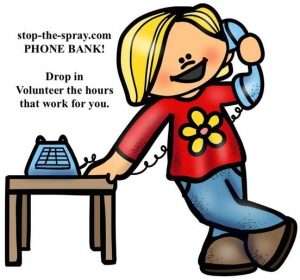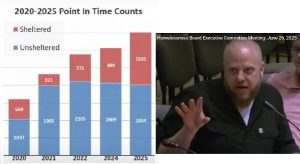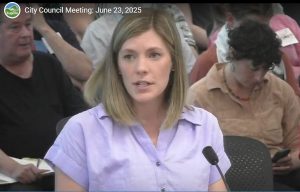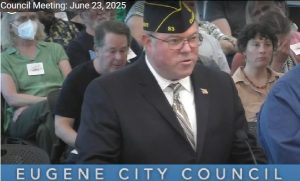Beaver Creek residents work with landowner to protect water quality
13 min read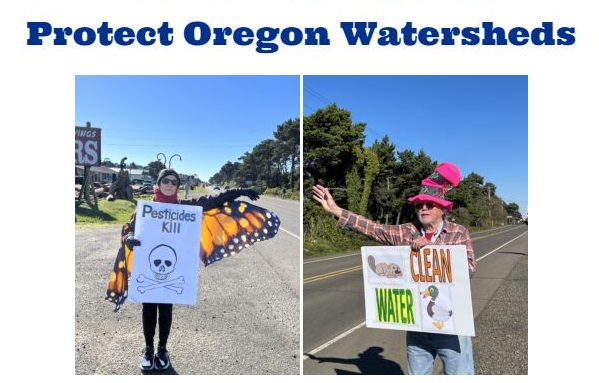
This summer, Sorn Nymark’s company got approval for an aerial spray to apply glyphosate to his timberlands. Upper Beaver Creek residents organized to learn more and to talk with the landowner. In early November, we caught up with Willow Kasner.
Willow Kasner (Beaver Creek): Different people in the community had a mixture of feelings, right? Anger and fear and begging for mercy and, you know, all different ways that different people reacted.
[00:00:22] The landowner wrote a letter saying that they were going to opt for backpack spraying instead of aerial spraying and it said it was due to the response from the community that he decided to switch their project.
[00:00:37] That was the best that he could offer, was backpack spraying, and that he said this is his retirement and that he is still trying to get the job done and still make his money and meet the standards of the Oregon Forest Practices Act.
[00:00:49] So they got the communication and yeah, decided to at least have some of the community’s fears taken care of. And I can say, it’s definitely a win. Definitely a win. It’s a win that shows that if communities don’t just roll over, if they strongly believe in something, then they need to say something, and they can gather information, and they can keep learning. And the trick is keeping the emotions in check so that people aren’t scaring each other, or doing anything threatening, or anything like that.
[00:01:16] It’s like a movement of the whole community just learning and doing what they can on all fronts.
[00:01:21] But yeah, we don’t need to let big business and big industry tell us what’s safe and what’s okay and what’s healthy and we just go along with it. It’s good to stand up and it’s great that most of the landowners will listen.
[00:01:33] And then that opened up another 14-day comment period where people still sent in comments, about 100 people, I think, sent in comments and then they had the go-ahead to start spraying.
[00:01:44] They started spraying slowly and one of our neighbors went there and talked to Tyrol, he’s the consultant, Tyrol Forfar, he’s the forester in charge of the operation. He talked to them and was shown the techniques and he saw the guys starting to work. And so that was pretty cool. He was able to update the neighborhood and felt pretty confident they’re doing the best that they can do within what they believe is safe. He basically talked to our neighbor explaining to him how safe everything is.
[00:02:12] I have a different belief on whether or not it’s safe. I personally don’t want chemicals anywhere around and most people don’t, but it’s still safe according to what’s legal and what a lot of people still believe.
[00:02:25] They basically got a eight- to nine-person crew. So they fill up their backpacks, go to the buffer lines in a row and then walk up the hill, spraying with their packs. And then they would go to another spot, go back down, march in a unit, walk in a unit, spraying. He said it looked like they were using a minimal amount and they were being as responsible as possible, spraying side to side with their sprayers as they walk up.
[00:02:49] I believe there was a woman out there from Department of Ag as well (Department of Agriculture) that day.
[00:02:55] And I think another good thing that happened here with this situation is, they were held really accountable. There’s no way to just go out there and go free-form and be like, ‘Ha-ha, we said we’re going to do this, but we’re going to do this.’ Because everyone’s watching and they know everyone’s watching and they know people are testing and it’s real.
[00:03:10] So if there’s any contamination, they want to prove they did everything in the right way and everything legal and so that also slows people down, I think, slows the job down enough to where yeah, they’re going to be very precise.
[00:03:23] And personally, I don’t agree with chemicals. I mean, I try not to eat them myself. I don’t want Monsanto’s food, I don’t want any of that, and I definitely don’t want it in my water or in the forest, but to find a balance, the least we can do, is make sure things are done the most clean way possible within the boundaries until things change to where that’s no longer seen as a economic value to do things that way.
[00:03:44] Because right now the companies have been told, ‘That’s the only way to do it,’ and so they believe that it’s a system that’s been done for so long. That’s what everybody’s just trained to believe is the way you do it and, there’s a whole another conversation about that. And I hope that it happens soon where people start realizing that’s not the healthiest, but it’s not the most economic way either.
[00:04:06] John Q: Willow Kasner from Beaver Creek, who helped organize her community to talk with a forest landowner and reconsider an aerial spray. They switched to a crew with backpacks.
[00:04:16] Willow Kasner (Beaver Creek): Yeah, they’ve been doing it on sunny days. They have to time it to where it’s not going to rain that next day, But yeah, there’s a crew of eight to nine guys, I guess they’re really strong fellows, they can just walk up and down on all this rugged, hilly terrain pretty quickly and pretty efficiently.
[00:04:34] They came in with a few trucks and a couple of trucks with trailers to hold the spray or the liquid mixing unit. I got some more information on how they do it recently. They mix 100 to 200 gallons at a time, and then when their backpacks are empty, they go up to the tank, and they refill their packs, and then they go out again.
[00:04:53] And basically one small team, little by little, is doing it all. And then there’s another truck with a big tank on it that’s just water for them to mix, so they’re not using water from the creeks or anything, which is really important for us, not redipping any tools or buckets or anything, that—
[00:05:12] I’ve seen some scary videos in the past about that and they assured me they wouldn’t be doing any of that, and it sounds like they’ve not been. They’ve had Department of Ag out there with them, which we were wanting and then they were wanting as well, I guess just to prove that they’re doing it, legally.
[00:05:28] And I think it’s good for everybody involved just to feel more comfortable that someone’s watching, they’re not rushing through.
[00:05:34] So, I feel like all of the community’s pressure and worry and everything was really positive, obviously, because that’s why they decided to do backpack spraying instead, where if it was aerial, it’d be done in one day.
[00:05:45] And as we know, the weather down here changes so quickly, at least in the little valley where we are, no matter what anybody says about the weather being okay to do that, we still have lots of worry, and so if anything else it kept some of the fear, of everybody down and the emotional stress of it by switching to the backpack.
[00:06:06] There’s actually another one added to the backpack spray mix, which we were extra unhappy about the added chemicals. But as far as emotionally, I would say that it definitely helps with the fear factor and the emotional stress that the families have, especially the ones that were the most concerned and the closest to it.
[00:06:23] People don’t need extra worry and extra stress and fear and looking outside and every time there was a helicopter or anything in the air heard, people in the neighborhood were contacting each other and worried and wondering if that was it, and ‘Is this the one?’ and ‘Have you heard anything?’ And, so, yeah, community, worry and fear was pretty big.
[00:06:40] And it calmed people down in a positive way, and however, people that are really against the chemicals, the use of the pesticides and herbicides everybody’s still, researching and looking into things and learning and trying to educate.
[00:06:55] There was a comment from somebody else in the community saying, ‘Well, they should pay for the difference, of what’s the landowner lost from aerial versus backpack,’ and then it was brought to my attention by somebody else, ‘Hey, that’s a write-off for them, you write off your expenses as a business.’ So that’s not directly out of somebody’s pocket per se. And then there’s somebody else saying, ‘Well, the owners, the landowners, or the company should be paying for the locals that have to spend money on their own testing, to get their own water tested, because it’s really expensive.’
[00:07:25] We researched a bunch of different options before any of the tests were sent in, but 12 tests were sent in beforehand of different prime locations around the whole area because, they’re so expensive. They’re about $600 a test is what it turns out.
[00:07:41] For example, you don’t test for glyphosate, you test for glyphosate AMPA, because if you just test for glyphosate, it’s never going to be there because it’s already broken down into other chemicals. You have to test for the breakdowns as well. And then you have to know what your chemicals are and then, test for the exact thing.
[00:07:59] So with what we needed, it’s about $600 apiece. And I think soil is a little more expensive than water. But yeah, so it’s a lot of money raised to be able to have a test. And then some testing being done now, or some samples being taken now, once the rains have started, to see if there’s any runoff.
[00:08:15] Urine samples ended up not happening. And that was in part because of the backpack spraying, the theory was that it’s just not as intense as one-time (spraying). And since you don’t know when they’re going to be spraying each section, you don’t really know when they’re done. It would have been nice if each neighboring landowner was able to tell.
I did ask them which sections they were going to do first and what their plan was. But I didn’t get a response on like their plan. We just knew where they started because one of our neighbors was there talking to them. And so I figured, ‘Okay, they’re starting in the east corner and they’re working their way out,’ which is I think what they did, but they can’t tell us. They don’t know until they have the weather for each day. And then they also have other jobs they’re doing in Washington and Oregon, and so the crew has to decide which job has priority.
So there were some really sunny, hot days out here and people were stressed and shaking in their boots, thinking, ‘They’re coming today. They’re coming today,’ calling each other, ‘Have you seen them? Have you seen them?’
[00:09:13] And then it turns out they didn’t show up and everyone’s like, ‘What’s going on? Are they not going to do it? Are we clear?’ It turns out ‘cause they had other jobs as well and had to organize that.
[00:09:21] John Q: Now that the spraying is mostly, if not all complete, the movement plans to build on its success.
[00:09:28] Willow Kasner (Beaver Creek): There’s going to be an actual group forming to protect watersheds separately from that movement, but inspired by the movement. There’s been lots of talks between people of how to best benefit the community.
[00:09:43] Like I said, as we educate ourselves, educating the community, and I’m really interested in the whole community getting a real education on what’s going on beyond what we’re told and beyond what we’re taught and beyond what’s going on for, been just going on that we don’t realize maybe has more of an impact than value—on the community, on our weather, and on wildfires and all of this. It’s like, there’s misinformation happening all around the world, right?
[00:10:11] This is nothing new, but people seem to be so separated in two separate sides and each side believes the other side has misinformation. And/or believes the other side’s just mean or whatever and it’s going against the information that the one side knows.
[00:10:25] The truth is we all have different information and we need professionals and independent studies and real graphs and charts and surveys and numbers and all that to show what’s really going on and share that with each other. So that’s what my personal dream is right now, that we can learn everything possible from reputable places and people and institutes and schools and really see non-biased reports on all of this.
[00:10:54] And then learn as a community together what’s really going on, how it really affects us as a community and as a state, and then choose to make changes together—whether we change legislation, whether we change our individual practices, learning things like the actual economics, like how much of the trees really go towards wood and how much is actually left behind.
[00:11:15] And how much is this degrading the forest, the soil, and the ability to maintain moisture in the forest and help wildfires, vs. how much of these activities are actually causing wildfires or aiding in wildfires and that kind of stuff. We can all get on the same page.
[00:11:33] I feel inspired by it. I’m from here, so it really is important to me, my whole community. And I still have logger family members from the generations—generations and generations and generations. And I want them to thrive and I want all my whole community to thrive because I like community. I like people a lot. I like people and animals, forests and trees, and I like all of it. And I really want to see us all thrive together.
[00:11:55] And we’re such a small community. We teach each other’s kids. We coach each other’s kids, we have slumber parties at each other’s houses where families don’t necessarily think the same. But there’s so many things we have in common: And that’s a healthy forest, and that’s a place to forage, and a place for the kids to play, and for people to hunt, and for the ground to stay moist, and the tree cover to be, the canopy to be sufficient to create biodiversity and also have an economy for the families that have relied on this for their economy forever.
And yeah, how to balance that is, is something that I’m really interested in. And I don’t believe separation works for anybody ever.
[00:12:37] So I am confident that we will all be able to communicate and come to the understanding that we’re all in this together. And if we work together as a unified force and stop letting outside forces—I mean, it’s not like it just started, we’re getting separated purposely so that we are not as strong and we need to be able to work together, make informed unified choices and actions, and take our own health of our community and of our land back.
[00:13:04] And it’s, yeah, it’s really the only way. Honestly, the division is literally killing us, making us sick. It’s loading us with unhealthy food. It’s, yeah, it’s just, it’s not cool and it’s time for it to stop.
[00:13:16] But the real changing solution, of course, is to fix the problem slowly and surely, work on the problem, not just another solution and another band-aid. And so we’re like, have to be simultaneously working on band-aids so we don’t bleed out as a people in the world. But yeah, finding out what the core problem is and how we can treat it on a core level, standing together and getting a community together to talk about and bring these issues out in the open and inform people, because so many people have no idea of any of these things going on.
It’s how we started. It’s how we incite a change and a growth and yet it’s once again a change for the whole community and it’s not an ‘us against them’ thing. It’s all of us, actual human beings, actual people that exist—it’s us, we the people, that are suffering loss of jobs, and loss of environment, and loss of health, and loss of everything. And so we need to work together to start changing it in the opposite direction.
[00:14:15] The fact that the community’s come together and there’s so much more conversation and it’s a really crucial time right now as new studies are coming out in 2023 and new laws, new regulations, and probably more separation intended for the rest of us. And so we need to catch that and nip it in the bud and I think that it’s pushed us all together at the right time, at the most important time.
[00:14:33] John Q: The people of Lincoln County come together to ask for a better solution, and it works. Willow Kasner says the community hopes to build on that success and continue learning together.
